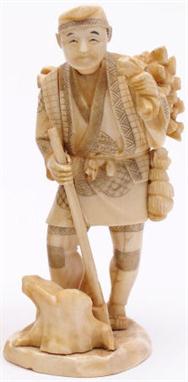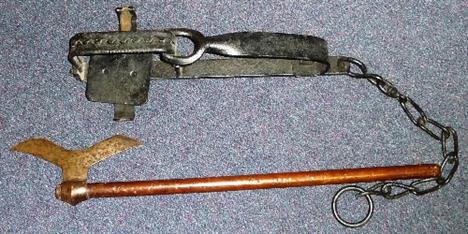*A Malayan axe, the iron head, approximately 17cm long, held to the shaft by twine, the wooden shaft with circular grip, approximately 68cm overall, together with two similar axes, an opium pipe, and a masai hand spear, with 13cm head, ebonised haft and secondary spear head, 75cm overall. These axes were most probably used for carving tribal masks. (5)
14782 Preisdatenbank Los(e) gefunden, die Ihrer Suche entsprechen
14782 Lose gefunden, die zu Ihrer Suche passen. Abonnieren Sie die Preisdatenbank, um sofortigen Zugriff auf alle Dienstleistungen der Preisdatenbank zu haben.
Preisdatenbank abonnieren- Liste
- Galerie
-
14782 Los(e)/Seite
LE REPOS AU CAMPEMENT Jean-Baptiste PATER (Valenciennes, 29 décembre 1695 - Paris, 25 juillet 1736) MATÉRIAU Huile sur toile Étiquette de collection sur le châssis et monogramme TC non identifié 61 x 75 cm Cadre en bois sculpté et doré d’époque Louis XV (reprises à la dorure) PROVENANCE Ancienne collection Jean Cailleux, en 1966 (Fig. 1) Vente Sotheby’s Monaco, février 1981, n°66 Collection particulière, Neuilly Collection particulière, Paris EXPOSITION « Plaisirs de la campagne ». Galerie Charpentier, Paris 1954, n°37 La scène principale, les soldats se reposant au campement en charmante compagnie, occupe l’axe central de la composition. Le sujet du tableau est une conversation galante entre deux jeunes femmes et un soldat. Un halo de lumière tombe directement sur la robe des élégantes, orientant ainsi directement l’oeil. Autour d’eux, deux soldats observent la scène : l’un debout se retourne, le regard empli de regrets, l’autre accoudé à un tronc d’arbre vu de dos. Sur les côtés, deux groupes s’affairent en ignorant totalement la scène principale : à gauche des soldats déchargent le foin d’une charrette ; à droite, deux femmes conversant entre elles portent du linge. Le fond de la composition en sfumato, s’ouvre sur une vue en contrebas de village. La tenue des soldats ainsi que la couleur générale renvoient aux réalisations du Nord de la France. Jean-Baptiste Pater, originaire de Valenciennes, fut baigné du spectacle des troupes militaires suite aux guerres sous Louis XIV et à l’installation de places fortes dans le Nord de la France après 1667. Fils du sculpteur Antoine Pater (1670-1747), il montra dès son plus jeune âge des dispositions artistiques. D’abord élève de son père, il devint à Paris, alors qu’il s’y installa pour ses études, élève d’Antoine Watteau (1684-1721). De caractère fort difficile, ce dernier se sépara très vite de son élève pour le rappeler quelques années plus tard en 1721 lorsqu’il sentit son état de santé se dégrader afin de lui faire acquérir les bases et en faire son héritier artistique. Il fut reçu à l’Académie Royale de Peinture et de Sculpture le 31 décembre 1728 comme « peintre des fêtes galantes » ou « peintre des sujets modernes ». Travailleur acharné, il eut la réputation de ne jamais s’éloigner de sa tâche, ne prendre aucune distraction. Ce surmenage eut des conséquences tragiques ; sa santé se dégrada rapidement et il mourut à 40 ans. Un des ses contemporains dit de lui « il vécut pauvrement afi n de pouvoir mourir riche ». Comme Watteau, il resta en marge de la peinture offi cielle, fournissant marchands et amateurs privés. Grand narrateur des moeurs de son époque, il puise ses sujets dans le théâtre italien ou dans les oeuvres de La Fontaine, de Molière et de Scarron ; parfait metteur en scène, il a su exprimer dans un cadre approprié le cérémoniel et les rites des fêtes galantes. Ses scènes villageoises et militaires offrent un cadre plus personnel : le gai et l’anecdotique rappellent les scènes familières des peintres des Pays-Bas. Les passages de troupes et les batailles dans le Hainaut rattaché depuis peu à la France, ont marqué Watteau et Pater, tous deux originaires du Nord. Mais si Watteau traduit avec gravité la vie quotidienne des troupes, Pater les traite à la manière des scènes galantes. Son dessin est d’un rendu délicat, les expressions de ses personnages, leur physionomie restent proches de la réalité, les coloris aguichant et le rendu de la lumière subtil et doux. On le loua beaucoup d’être resté fi dèle aux leçons de son maître. Il eut toujours pour lui une reconnaissance parfaite et lui rendit justice de son mérite à toutes occasions se présentant à lui. Ses oeuvres sont présentes dans les collections nationales, notamment au Musée du Louvre où est conservée « la fête champêtre, réjouissance de soldats », une composition plus fournie en personnages et en animations, mais qui reprend le même schéma de présentation : la scène principale sur laquelle tombe la lumière, des personnages autour à leurs activités et un arrière fond de paysage évanescent. On y retrouve le même rendu notamment pour la tente du campement, pour le tracé léger et aérien des branches d’arbres, la bonhomie des acteurs. Ce sont ces caractéristiques techniques qui permettent de confi rmer avec certitude les oeuvres exécutées par le Maître car Pater a peu signé durant sa courte carrière. Une gravure d’après Watteau titrée « détachement faisant halte » d’un tableau disparu, pourrait avoir inspiré Pater pour cette composition. Une oeuvre de format 25 x 31 cm, titrée « le repos au campement » faisait partie de la collection David-Weill (Fig. 3), référencée dans le catalogue par Gabriel Henriot, Paris 1926, tome II, n°389. Une autre, appartenant à l’ancienne collection Michel Levy, titrée « Le bivouac », semble être le pendant de l’oeuvre que nous présentons. Lors du rapport technique réalisé en 2006 par Mr Bedel de Buzareingues, l’examen a révélé une couche de préparation blanche, caractéristique des oeuvres peintes à cette époque par Watteau et Pater. BIBLIOGRAPHIE Florence Ingersoll-Smouse, Pater, éd. les Beaux-Arts, Paris, 1928
19th Century Figural AxeIron blade with stylized grotesque mask on both sides. Below the finial is another grotesque mask on one side and a serpent on the other side. Fluted iron base with stippled pattern. Overall length 23". Iron head 5.75" length and 6.5" from top of finial to the bottom of base. Condition: Very good.Starting Price: $400
A collection of approx forty 7inch vinyl records by Bob Marley and The Wailers, records included `Small Axe`, Punch label (PM 69), `More Axe` (US 372) and two copies of `Doppy Conquer` (US 348) on Upsetter labels, `Trench Town Rock` (GD 4005) and `Guava Jelly` (GD 4025) on Green Door labels, `Dancing Shoes` Rio label (R116), `Mr Brown` (TR 7979) and `Soul Shakedown Party` (TR 7911) on Trojan labels, `Stir It Up` Demo Island label, five DJ copies on Island labels comprising `Trench Town Rock`, `Natty Dread`, `Exodus`, `Waiting In Vain` and `Roots Rock Reggae`, an Island label promo for `So Jah Seh`, `Buffalo Soldier` promo, `War/Who The Cap Fits` Barbados pressing on Total Sounds label, and approx twenty three Jamaican pressings on a variety of labels such as Tuff Gong, Coxsone, Cobra, Fams etc (overall condition good) (illustrated)
AN OAK CASED SOLID SILVER COFFEE / TEA SET, LONDON HALLMARK, BY ELKINGTON & CO. 1903 COMPRISING TEAPOT, COFFEE POT, SUGAR BOWL AND MILK JUG, THE EBONY HANDLED TEAPOT AND COFFEE POT HAVING FOLIATE FRIEZE TO TOP PLAIN CENTRE WITH LAURELS TO SPOUTS, SHIELDS AND SHELL FORM TO LOWER FRIEZE ON FLORAL AND CLAW FEET, EACH PIECE ENGRAVED WITH A SEATED LION HOLDING AN AXE, THE FITTED OAK CASE HAVING A BRASS SHIELD TO THE TOP ENGRAVED SUSAN GARNETT ON HER 25th BIRTHDAY FROM HER AFFECTIONATE FATHER JAS. GARNETT WADDO JUNE 1st 1903, BRASS CARRYING HANDLE TO THE TOP, APPROX. WEIGHT OF SILVER 1460gm
Carruthers, JaneMELTON PRIOR: WAR ARTIST IN SOUTHERN AFRICA 1895 TO 1900Johannesburg: Brenthurst Press, 1987limited edition of 1000 copies4tob/w & col. illustrationscloth, dustjacket in mint condition Comments: and 2 others of related interest ? LE CORDEUR, B. & OTHERS - The War of the Axe 1847, 1981, dustjacket ? CARTER, A. C. R. - The Work of War Artists in South Africa, 1999, dustjacket, No. 103 of 1000. (3)
c750-600BC: Late Bronze Age socketed bronze axe head 5 by 2 in. R. G. Widdowson Antiquities, North Yorkshire; Whence purchased by the present ownerExtremely fine and rare Ewart Park Phase bronze axe head with three diverging ribs on each face and prominent mouth moulding. Found during Limestone quarrying in Cardiganshire, Wales in 1890.
2005 TVR Sagaris Car Year: 2005 Car Manufacturer: TVR Car Model: Sagaris Car Reg No.: L100TVR Car Chassis No.: SDLSA16A25B001174 Car Colour: Black Chameleon Designed by Graham Browne and Lee Hodgetts, the prototype Sagaris (the Greek name for a lightweight battle-axe) was unveiled at the MPH Show of 2003. The pre-production version then starred at the 2004 Birmingham Motorshow, yet it was not until 2005 that it finally became available to the expectant TVR enthusiasts. Conceived as a motorsport version of the T350 C, this was a racing car for the road; a Le Mans contender for the highways and byways. Below the bonnet of the `Blackpool Beast` lurked TVR`s 3996cc straight-six engine already known from the Tuscan S. This delivered some 380bhp and 349lbft of torque - sufficient output to fire the slippery two-seater to 60mph in just 3.7 seconds and on to a terminal speed of 185mph or more. Suspension was the traditional racing fare of double wishbones and coil springs at each corner and braking by sizeable ventilated discs all round - four-pot at the front and single pot at the rear. Steering was by power-assisted rack and pinion and the performance was delivered to the tarmac by 18-inch wheels shod with suitably meaty 255/35 section tyres. This is one mean-looking machine, its Black Chameleon hued bodywork teamed with dark-coloured alloys and a Black leather interior. It was purchased in September 2005 from marque specialist Christopher Neil for the not inconsiderable sum of ú55,425 and is being sold complete with the appropriate number plate - `L100 TVR`. The vendor classes the bodywork, paintwork, interior trim, six-cylinder engine and five-speed manual gearbox as all being in "very good" order. The odometer currently reads an unwarranted 25,894 miles and the current MOT is valid into July. An increasingly rare opportunity to purchase one of the great street fighters of the last decade, and what is generally agreed to be the best TVR model ever produced. Click Here to view this item on www.i-bidder.com
Six Japanese ivory okimono and netsuke, late 19th/early 20th century, comprising a figure of a street trader with minogame, stencilled details, 9cm high, a woodsman with axe and branch of fruit, 11cm high, a small coloured ivory figure of a fisherman, 5cm high, a figure of Ebisu on two straw bales with a child at his feet, (at fault) 4cm high, a figure of an old man with long beard, 3.5cm and a netsuke of a fisherman with his catch, 7cm high (6) WE DO NOT STATE CONDTION IN THE ABOVE DESCRIPTION – Before bidding please ensure you are satisfied with the condition of this lot – For details of condition please contact the auctioneer.
A Collection of Mining Related Equipment, including a set of brass measuring chains, ten leather bound lead weights for holding open mine plans, a wooden cased mechanical detonator plunger, leather exploder box, first aid box, a cased aspirator, fire extinguisher, helmet, miners hat, pick and axe heads etc
-
14782 Los(e)/Seite
























































